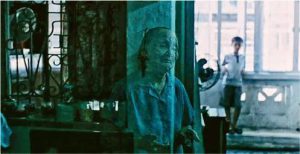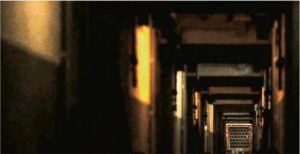In Fruit Chan’s film, defamiliarization is achieved by the cinematic representation of well-known urban spaces in Hong Kong, such as low-cost public housing estates and old neighborhoods. By utilizing light, warped space, shadows, twisty images…… Chan renders these familiar spaces mysterious and ghostly. Thereby challenging the audience’s perception of the city. From my perspective, there are two reasons:
1. Ghosts represent the feeling of anxiety, disorientation, and uncertainty when Hong Kong was handed over from the British in 1997. For example, the young girl Susan(Fig.1) in <Made in Hong Kong> or the dying grandmother(Fig.2) in 《Little Cheung》, they are actually not ghosts, but rather metaphors for the sense of unease and discomfort by many Hong Kong citizens during the handover period.

Fig.1《Made in Hong Kong》— Girl Susan
(source: Movie Screenshot)

Fig.2 《Little Cheung》— Dying Grandmother
(source: Movie Screenshot)
2. The depiction draws attention to the overlooked issues in Hong Kong, for example, the public housing policy and people’s living(Fig.3). Using dark images or shadows could make the space unfamiliar, thus highlighting the emotional and psychological impact on Hong Kong residents.

Fig.3 《Made in Hong Kong》— Public housing is depicted as an abandoned space
(source: Movie Screenshot)
From an architectural perspective, by making the familiar unfamiliar, this technique reminds us that architecture is not just a place for human activity, but also intimately intertwined with the emotional, psychological, and political lives of humans.
Cui Yuxiang 3036218184